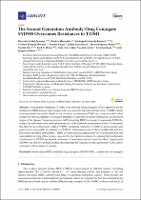The Second Generation Antibody-Drug Conjugate SYD985 Overcomes Resistances to T-DM1

Author
Date
2020-03-13Permanent link
https://hdl.handle.net/11351/6235DOI
10.3390/cancers12030670
ISSN
2072-6694
WOS
000530232300146
PMID
32183023
Abstract
Trastuzumab-emtansine (T-DM1) is an antibody-drug conjugate (ADC) approved for the treatment of HER2 (human epidermal growth factor receptor 2)-positive breast cancer. T-DM1 consists of trastuzumab covalently linked to the cytotoxic maytansinoid DM1 via a non-cleavable linker. Despite its efficacy, primary or acquired resistance frequently develops, particularly in advanced stages of the disease. Second generation ADCs targeting HER2 are meant to supersede T-DM1 by using a cleavable linker and a more potent payload with a different mechanism of action. To determine the effect of one of these novel ADCs, SYD985, on tumors resistant to T-DM1, we developed several patient-derived models of resistance to T-DM1. Characterization of these models showed that previously described mechanisms—HER2 downmodulation, impairment of lysosomal function and upregulation of drug efflux pumps—account for the resistances observed, arguing that mechanisms of resistance to T-DM1 are limited, and most of them have already been described. Importantly, SYD985 was effective in these models, showing that the resistance to first generation ADCs can be overcome with an improved design.
Keywords
T-DM1; Antibody-drug conjugate; Breast cancerBibliographic citation
Nadal-Serrano M, Morancho B, Escrivá-de-Romaní S, Morales CB, Luque A, Escorihuela M, et al. The Second Generation Antibody-Drug Conjugate SYD985 Overcomes Resistances to T-DM1. Cancers. 2020 Mar 13;12(3):670.
Audience
Professionals
This item appears in following collections
- HVH - Articles científics [4476]
- VHIO - Articles científics [1250]
The following license files are associated with this item:

 Private area
Private area Contact Us
Contact Us







